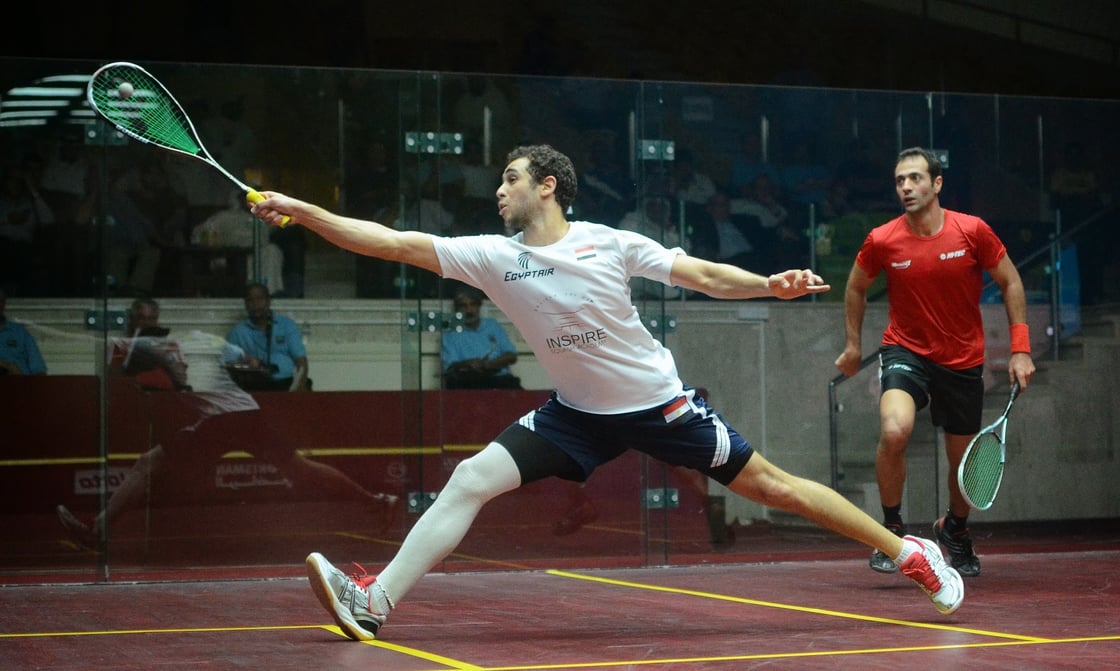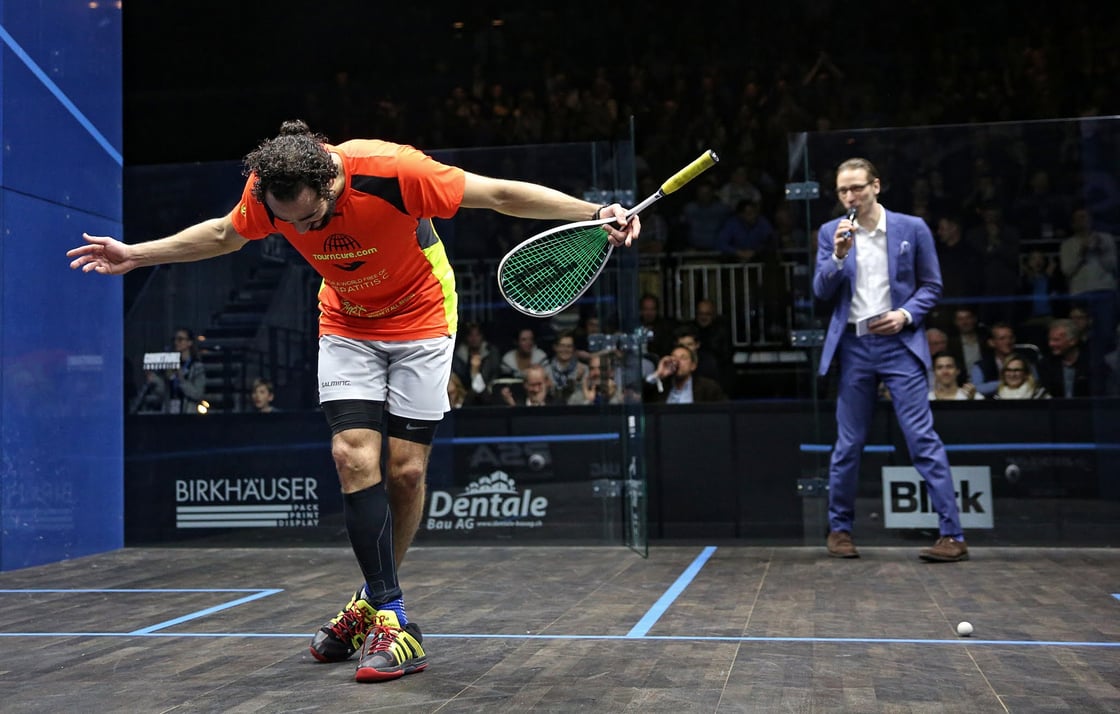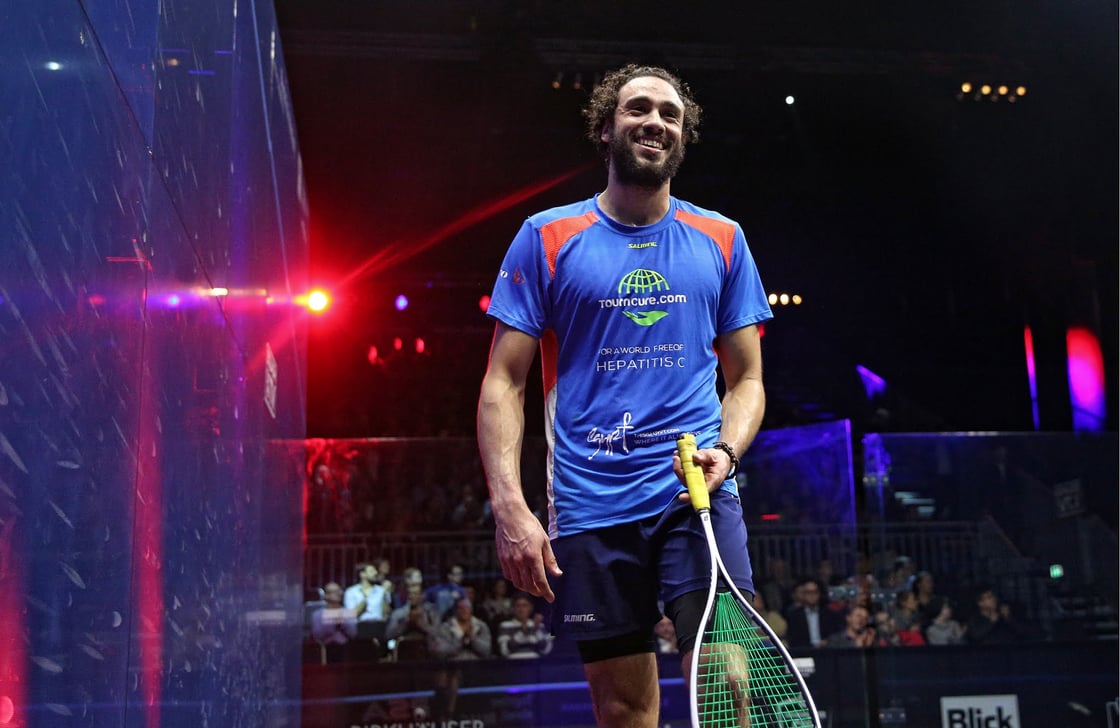A while back, I talked through some of my favourite World No.1s throughout history.
It was a great one for me to write since I learned so much, and, it also got me thinking that I often focus articles on current squash professionals, and, I don't think I've actually done any focused player profiles on retired squash legends.
So, I thought I'd start now!
Although there have been many, many World No.1s since the inception of world rankings, there's one name for me that comes to mind first when I think of my absolute favourite World No.1 of all time.
Perhaps your the same as me, or, perhaps you have a different favourite, but, it took me all but a few seconds to decide to write this week's article on Ramy Ashour.
Chances are, you already know about Ramy, but, hopefully you still learn a thing or two about the Egyptian this week (I know I did just from writing this)!
Regardless, I'll be talking about the history, uprising, style, achievements, struggles, and comeback of The Artist, AKA Ramy Ashour, let's dive in...
Ramy's History, Early Life, and Rise to Prominence
Ramy Ashour was born on September 30, 1987, in Cairo, Egypt, a city that would later become the heart of modern squash dominance. Growing up in a country with such a rich squash tradition, he was immersed in the sport from an early age.
Unlike many juniors who develop their game methodically, Ramy’s talent was immediately striking.
At least, this is what I found from my research online. Before I go any further, if I do get anything wrong moving forward, please feel free to fact-check me and drop us an email so I can make corrections!
Anyway, it sounds as though Ramy possessed that instinctive flair, an ability to read the game from a very young age.
It was almost as if he already had the wisdom that older, much more experienced players have had to painstakinly learn through hours of match play.
However, it was Ashour's natural creativity that made him stand out.
His older brother, Hisham Ashour, was also a professional player. Although his name isn't mentioned as much, he's got a strong squash resume under his belt.
Hisham coached Ramy, and, also is said to be the creator of the 'Mizuki' shot, which is essentially a backhand volley where the racquet face is twisted upside down before striking the ball. A tough trick shot to play, but, a lot of fun too!
Anyway, by the time Ramy was a teenager, he was already making waves in the junior circuit.
His rise was pretty rapid, and in 2004, at just 16 years old, he won his first World Junior Championship, becoming one of the youngest ever to do so.
I believe that Jansher Khan held that record at the time, however, it was actually very recently beaten by Mohamad Zakaria.
All three of the above were 16 when they won the World Junior Champs, but Zakaria takes the cake for being the youngest.
Ashour also went on to win his second Junior World Championships in 2006.
Jumping up into the professional circuit and beginning to play adults, Ramy was by no means out of his depth. Junior players often take time to adjust to the physicality and speed of the professional game, but, as you might have expected, Ramy was different.
His unique combination of deception, movement, and sheer shot-making ability meant he was already playing a style that many professionals struggled to counter.
His second World Junior Championship title in 2006 cemented his status as a once-in-a-generation talent, making him the first player in history to win the event twice.
His dominance in the junior circuit naturally led to comparisons with other squash legends. Players like Jahangir Khan and Jansher Khan had also burst onto the scene at a young age, rewriting the rules of the game.
Even speculative comparisons between squash legends can draw some controversy, but, in the long term Ramy certainly proved his worth!
By the time he transitioned to the senior circuit, expectations were obviously high, which must have put a lot of pressure on Ramy, however, it turns out that he performed even better under the spotlight!
Within a year of turning pro, he had already broken into the world's top 20, taking down some of the biggest names in the sport.
Ramy's route to the top of the rankings wasn’t a gradual climb, he absolutely shot to the top, and, from then on, it was pretty clear that he'd be staying there a while!
Even if you look to the current pros, many of whom faced Ramy in his prime, they're full of admiration for The Artist. Even current World No.1, Ali Farag, has admitted that Ramy’s genius was 'unparalleled'.
This leads quite well into the next section, you see, there's a reason why, if you ask any squash player or fan who their favourite player of all time is, there's a good chance that their answer will be Ramy...
While other players were exceptional in their technical execution, Ramy’s game had an improvisational (and even unorthodox) beauty, he played squash like an artist...

Image credit: Steve Cubbins
Playing Style: A Genius at Work
Ramy Ashour’s playing style was unlike anything the squash world had seen before, it was almost hypnotic.
His shot-making was pure artistry, hence his nickname (The Artist), it was fluid, instinctive, and ridiculously unpredictable.
Generally, squash is a pretty fast sport, however, the professionals often play a very structured game that focuses on consistency, minimising risk (and therefore errors), and waiting patiently for the right opportunity.
Ramy, on the other hand, could speed up and slow down the pace of play at will, and, he could seemingly play winners from anywhere on the court. Risk wasn't a word that was in Ramy's vocabularly, meaning that his opponents had to cover every single corner of the court at all times.
His backhand, in particular, is one of my favourite things about Ashour's game.
He had a very unorthodox looking swing style that was very low on the backswing, and, full of wrist (when he wanted it to be).
This allowed him to generate astonishing deception, drops, flicks, kills, and holds.
Opponents often found themselves frozen or flat footed, unable to anticipate where the ball was going next.
His movement was just as remarkable as his racquet skills, although it's not necessarily talked about as much.
He combined fluidity and explosiveness in a way that made his game look effortless.
Ramy had a unique way of gliding around the court, using his light-footedness to be ready to push off at any given moment.
His ability to take the ball early, cut off angles, and control the 'T' meant that he was always dictating the pace of play, even against the world’s best defenders.
You'll have no doubt seen the array of different pictures on the internet of Ramy diving for the ball too. His explosivity was absolutely crazy, and, it is a great depiction of his drive to reach every single ball.
Ramy’s personality on court also made him an absolute joy to watch.
He played with an awesome energy, always smiling and engaging with the crowd.
Ramy really thrived on the big stage.
Sometimes, when players go for crazy winners and unorthodox shots, it can come off as arrogant, however, when Ramy does it, you can just tell that it was how he loved to play the game.
I think that love for the game made Ashour even more dangerous
You may have experienced something similar when playing, but, when you're truly comfortable and enjoying yourself on court, you feel unstoppable and confident that any shot you play will go in.
Now think about a professional player with that level of confidence all the time, and you've got Ramy!
This is why we call him The Artist.
The Artist’s Dominance, Rivalries, and Achievements
I touched on the fact that Ramy was a two-time World Junior Champion, but, of course, his dominance didn’t stop there, it was now time for the senior circuit.
At just 21 years old, The Artist became the youngest player since the legendary Jansher Khan to win the PSA World Championship, defeating Karim Darwish in an all-Egyptian final.
This victory cemented his status as the future of squash, and it wasn’t long before he climbed to the top spot.
Ramy first reached World No.1 in 2010, and over the next few years, he was the defining force in the game.
At his peak, he put together one of the most dominant runs in squash history, winning 49 PSA titles, including three World Championships in 2008, 2012, and 2014.
Ashouor's 2012-13 season was particularly ridiculous. He went unbeaten for over a year, winning 49 consecutive matches.
While that doesn't really come close to Jahangir Khan's 555 match win streak, it's still a pretty ridiculous number. I don't think I've won more than 5 matches in a row in my life as an amateur.
Maybe I'm a little biased since I was a junior around this time, but, in my head, I see this period as a golden phase of professional squash.
While legends like Karim Darwish and Amr Shabana were a little older than Ashour, he still faced them regularly and must have learned a heck of a lot from those clashes.
It was during Ramy's prime that he dveloped strong rivalries with players like Nick Matthew, Gregory Gaultier, and Mohamed ElShorbagy.
His battles with Matthew were some of the most physically intense. Against Gaultier, their matches were high-paced and full of shot-making. And, his clashes with ElShorbagy, especially in the latter part of his career, were just full of sheer squash brilliance.
Many of these matches can be watched back on YouTube and other platforms, and, I'd highly recommend giving them a look if you get the chance!

Image credit: Steve Cubbins
Injury Struggles
Unfortunately, I'm sure many of you knew this section was coming, but Ashour's career was plagued by persistent injuries that arguably cut his dominance short.
His biggest battle was with recurring hamstring and knee issues, which first started troubling him in the early 2010s. As time passed, injuries kept him in and out of the tour, forcing him to withdraw from multiple tournaments and spend long stretches away from the game, disrupting his momentum just as he seemed on top form.
Of course, all of this is a massive testament to The Artist's mental strength, but the toll on his body must have been so difficult to face.
Many thought that might be it for Ashour...
Ramy's Comeback
After that hamstring injury in 2010, Ramy's first major comeback came at the 2011 Tournament of Champions, where he announced his return in style by defeating Nick Matthew in the final, showcasing his trademark shot-making and creativity.
It was like he'd never been off the court!
However, Ramy fans will know the match I'm about to mention next, and that was the 2014 World Championship final against Mohamed ElShorbagy.
This was one of the craziest matches in the history of squash.
After an insanely brutal battle, Ramy somehow found a way to make a comeback and win in the fifth game, despite barely being able to move in the closing stages.
There are clips and interviews about this online and they never fail to wow me.
The Artist's final significant comeback came in 2015 when, after another extended absence, he returned to win the El Gouna International PSA World Series event, once again defeating ElShorbagy.
Although those injuries really affected Ramy’s ability to play his best, the fact he was able to return and immediately win at the highest level was something rarely seen in squash, or any sport for that matter!

Image credit: Steve Cubbins
Ramy Ashour's Legacy, Influence, and Life After Squash
Ramy Ashour's impact on squash extends far beyond his titles and rankings and he'll no doubt be remembered in the sport for a very long time.
I could go on and on about how he's impacted the sport. My coach would always show me clips of Ramy and dissect little movements and technical things I could try out for myself.
But overall, I think his style and persona will inspire people for years and years to come.
Ramy Ashour officially retired on April 22, 2019, at the age of 31, which is young considering we have players like Miguel Rodriguez who is still playing awesome squash on the PSA Squash Tour at the age of 38!
However, despite pursuing his love for singing and producing some of his songs, Ramy remains a very active presence in the squash world.
He regularly shares videos on social media, often posting clips of himself playing for fun, still hitting outrageous winners with the same relaxed, effortless style that defined his career.
I believe he does some coaching too, but I may be wrong. Either way, I hope he stays involved in the squash world for as long as possible as his knowledge is invaluable to the sport.
While injuries ultimately cut short his time at the very top, Ramy Ashour’s legacy is secure.
He remains a unique figure in squash history, not just for his achievements but for the way he played the game, entertaining crowds and making everything look easy in a way few others ever have.
Final Thoughts: Will There Ever Be Another Ramy?
No, there's only one Ramy Ashour.
I guess this one is a pretty silly question because I've just spent this entire newsletter talking about how ridiculously unique Ramy was.
Maybe a better way to word it would be, will there ever be anyone like Ramy?
My answer to that is, I hope so.
I think our sport needs players like this to grow and thrive. We need more exciting personalities and people who draw a crowd.
I know it's a controversial name to mention, but, I think that Mostafa Asal has come a long way since he first emerged onto the PSA World Tour, and, there's no denying that he's going to be heavily inolved in the future of the sport.
I'm not necessarily comparing him to Ramy, but, I think I'm starting to come around to the way he plays and interacts with the crowd.
He's been working with James Willstrop on his game and I think the changes have been very apparent. I will admit, at first I wasn't a fan of the young Egyptian, but, I definitely enjoy watching him now.
Controversy aside, Asal's a spectacle of explosive flare and power that draws crowds, whether they love him or hate him. I think that, if he keeps changing his game for the better, he could be just what the sport needs.
But, of course, we need more players like that if anyone is going to replicate the likes of Ramy!
Anyway, I'll stop there before I go off on a tangent.
Thanks for reading and please feel free to get in touch if you have any ther players you'd like me to focus a profile on!
This article was taken from our On The 'T' Newsletter, if you're interested in receiving more content like this, please feel free to sign up using the subscribe section located at the bottom left of this page (or underneath the article if you're on mobile), thanks!
